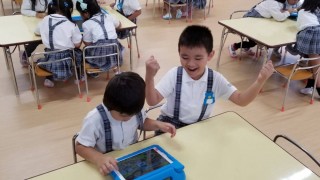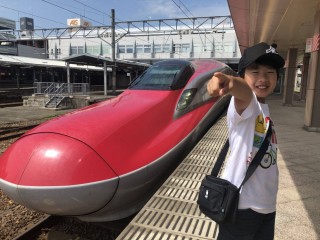Loading
Search
▼ The Possibilities (And Perils) Of Japan’s Youth Spending More Time Online
- Category:Other
Kids are savvy internet users; schools are stuck in an analog world
At the age of 2, Koya (whose last name is being withheld to protect his privacy) began to make videos on YouTube. Dressed as Spider-Man or the superhero Kamen Rider, he would perform for the camera, imitating content he discovered on the platform.“Koya is a YouTube native in an era where content production has shifted from professionals to amateurs,” his mother says. With her help, he crafts creative and whimsical clips. Nemi-chan, his cousin, has since joined as a co-host; together they unbox toys, prepare candies and perform short dramas for their growing following — videos made by kids, for kids.
Eight years later, their channel, KidsLine, has 12.3 million subscribers, making it the most followed channel based in Japan and the country’s first to exceed 10 million. “It’s their sensibility as children that makes the videos so special. It’s something that I would never be able to reproduce as an adult,” his mother adds.
The origins of today’s digital environment for children predate the pandemic, the byproduct of a decades-long history. In 1990s Japan, it was Tamagotchi, pagers and Nintendo video games, kicking off an era of interactive entertainment. By the early 2000s, smartphones and mobile internet was a part of the cultural fabric, becoming ubiquitous in the 2010s according to the Ministry of Internal Affairs and Communications; this was the era of participation and connection through technology.
With the spread of COVID-19, it was inevitable that we all became more dependent on technology for university classes, for work, even for groceries. In Japan, as elsewhere, kids are using technology more often, and for longer periods of time. Even though most public primary, middle, and high schools here never switched to remote education, the soaring amount of time children spent on screens at home — studying, connecting with friends and playing games — put many on alert.
In a study published in December 2020, the National Center for Child Health and Development (NCCHD) surveyed parents and found that, compared to January of the same year, 41% of respondents reported that the use of electronic devices by children across all age groups in Japan either “increased” or “greatly increased.”
“I’m seeing more kids who, because they have to stay at home, because they can’t go outside as much, because of the (previous) state of emergency, are playing more interactive games with their friends. So, they are staying connected using technology,” says Warren Apel, the director of technology at The American School in Japan, an international private school in Chofu, Tokyo.
“There’s been a dramatic increase in views worldwide. And also, for our apps, if we focus on just Japan, we have reached an average of 120,000 daily active users. Traffic has almost doubled,” says Kohei Kawamura, a planner at BabyBus, which produces apps and educational YouTube videos for kids.
But this boost hasn’t been reflected in the classroom. In 2018, Japan ranked last in the Organization for Economic Cooperation and Development for the adoption of digital technologies in schools. And so, in 2020, most Japanese schools were widely unprepared for online learning.
“In Japan, we have not used digital technology in school and in learning,” says Nanako Ishido, a professor at Keio University Graduate School of Media Design and president of nonprofit organization Canvas, which strives to transform learning through technology. “However, I think that will change dramatically in the future. With the COVID-19 outbreak, everyone is now using digital technology to do various activities at home. I think the level of digital usage has increased dramatically.”
The pandemic has revealed a paradox: Kids can be savvy internet users, with millions of followers, while their schools are stuck in an analog world of paper and pencils. And even though many kids were already skilled at using the internet to communicate, those skills needed to be quickly converted for use in an educational setting. Some schools did succeed. In February 2020, as reports of COVID-19 swirled, The American School in Japan convened a crisis response team that began to hatch contingency plans for distance learning.
The administrators revised the school’s distance learning plan, first created as a contingency in response to the H1N1 pandemic in 2009 and modified after the 3/11 disaster.
On March 4, 2020, the entire school went remote. The students were already digitally literate and each used a device, which took on a new significance in remote learning. Apel says that students also began to use new online learning platforms, such as Kami, Exam.net and Education Perfect.
“I think it affected different teachers and grade levels differently,” he says about the sudden transition. “Everyone had to do their work differently.”
As students began to use devices with greater frequency, parents had concerns, so Apel and his colleagues held seminars to teach healthy habits with technology.
“One of the things we work on with children is being actively aware of why they are using an app,” Apel says. He and his colleagues emphasized the distinction between passive and active consumption and the importance of intentionality with devices — lessons they had already been teaching pre-pandemic. “(Asking) ‘Are they being intentional and being reflective about the amount of time they spend?’ is a good way to make sure they are aware of what they are doing.”
The school returned to in-person classes on March 17, 2021.
Still, it’s clear digital learning is here to stay. But how will it influence education, and how will teachers, educators, students, parents and administrators incorporate technology in the coming years? Yu Kusakabe, CFO of Smart Education, a startup he co-founded in 2011, emphasizes the need for a hybrid of digital and analog.
“When you cut a piece of paper, you get a much cleaner result by using a pair of scissors. But in some cases, you might as well prefer to tear it by hand because of the feeling it produces,” Kusakabe says. “Information and communication technologies (ICTs) are the scissors of the 21st century.”
The company creates educational tools for kindergartens and focuses on developing noncognitive skills, including goal-setting, persistence and teamwork. In the curriculum, the tablet, like a pair of scissors, is one of the many instruments in a student’s toolbox.
Kusakabe says that a kid may draw on paper but then, through a tablet, modify and share the drawing with classmates. “We want more kids to see these devices as tools to express their creativity and imagination,” he explains.
“We will be able to make learning exciting by using video and other media,” Ishido says. “Teachers and students will be able to connect with each other, and students will be able to teach and learn from each other.”
Outside of institutional channels, new projects that blend play, creation and learning are slowly emerging; these are the products of long-term change, further accelerated by the pandemic. Ryusuke Ikeda, the father of the YouTube star Gacchan, who started his career at the age of 3, is preparing to debut a new YouTuber school for kids.
He envisions it as a place to learn how to communicate with others while confronting risks endemic to online usage. “It’s crucial for kids to learn about the value of personal information and recognize the risks of sharing private data,” he explains.
“The ability to perform tasks exactly as told won’t be needed in the future, as artificial intelligence and robots will do those tasks,” Kusakabe says.
COVID-19 has shined a light on the uneven adoption of digital technology for children in Japan, especially in the realm of education. Still, the exceptions help chart a course for the future.
“Since collaboration between people and creative thinking are things that only humans can do, wouldn’t it better to invest in an education that focuses on those skills?” Kusakabe asks.
- April 3, 2021
- Comment (0)
- Trackback(0)




